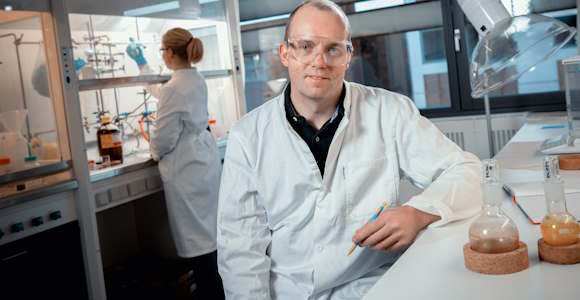
Molecular Machines: The Technology of the Future?
Jan Oskar Jeppesen builds machines out of molecules. His vision is that one day they could be used in technologies we can currently only dream of—like tiny computers with immense storage capacity or small nanomotors.
Why did you become a researcher?
I’ve always been curious about how things work. As a child, I loved taking apart things like old televisions to figure out how they functioned. I also loved using my creativity—not for drawing, but for building new things with LEGO bricks. In school, especially in high school, I was fascinated by the natural sciences, but it wasn’t until university that I realized chemistry—especially organic synthesis—would allow me to use my creativity and curiosity to create new materials.
The creativity and fascination I had building with LEGO have carried into my research, where I now use organic synthesis to build electrically driven molecular machines. Organic synthesis is, in many ways, like building with LEGO: we use molecules as building blocks, and theoretically, only imagination and creativity limit how a synthetic chemist can assemble them.
What other career plans did you have?
As a young child, I dreamed of becoming a farmer. I went to school with several boys whose fathers were farmers, and I found the large agricultural machines incredibly exciting. At the end of primary school, in high school, and during my early university years, I competed in athletics at an elite level. I became the Danish junior champion in hammer throw and dreamed of going to the Olympics and becoming a professional athlete.
Eventually, I realized that this might not be realistic and focused more on my studies. In my second year at university, I started teaching math as a TA, which I found very exciting and inspiring. At that point, my dream was to become a high school teacher in chemistry and math.

Jan Oskar Jeppesen
Professor of Chemistry at the Department of Physics, Chemistry, and Pharmacy. During his time at SDU, Jan O. has spent time abroad, including research stay at the University of California at Los Angeles (UCLA), where his PhD advisor was the future Nobel Laureate Sir Fraser Stoddart. Jan O. has received several honors, including the Danish Royal Order of Dannebrog and the Villum Kann Rasmussen Foundation’s Annual Award. Supporters of his research include the Independent Research Fund Denmark and the Carlsberg Foundation. Find more about Jan O. Jeppesen here.
What question would you like to find the answer to?
I’ve never been driven by a specific question I wanted to answer. I know that many of my fellow researchers often have a concrete problem they want to solve—like understanding how a certain enzyme works. For me, the motivation has been to use my creativity to create new materials with unknown properties and then figure out how they actually work.
That’s why, during my PhD at Nobel Laureate Sir Fraser Stoddart’s research group at UCLA, I became fascinated by so-called molecular machines that are driven by electricity. These molecular machines are in many ways similar to electric motors, converting electrical energy into mechanical motion. But the big difference is their size. Molecular machines are unimaginably small—typically just a few nanometers (one nanometer is a billionth of a meter).
How do you hope others will benefit from your research?
My research is truly fundamental science. The most important goal is to understand how molecular machines and motors can be built and how they function. I hope that future generations of researchers can build on the knowledge my research has provided. And who knows—maybe in 30 or 40 years, we’ll see a technological revolution on the scale of when the first electric motor was invented, about 200 years ago.
What do you have in your office that most people don’t?
LEGO bricks. They’ve been with me since childhood, and I genuinely believe they’re one of the best ways to develop creativity. The LEGO bricks in my office aren’t toys, though—I use them to build models that illustrate how molecular machines are structured and how they work. I use the models during lectures and pass them around to the audience.
Who do you admire?
I admire people who use their talent and dedication to make a difference for others and who don’t give up, even in the face of adversity. For me personally, the key reason I became a researcher was meeting my PhD advisor, Sir Fraser Stoddart. He grew up in poor conditions as the son of a sheep farmer in Scotland, and an academic career was far from guaranteed.
Through hard work and a long career full of setbacks, he became one of the world’s most influential chemists. In 2007, he was knighted by Queen Elizabeth II of England, and in 2016 he received the Nobel Prize in Chemistry along with two other chemists. His ability and dedication to help and inspire others to pursue their dreams were truly exceptional, and that’s why he’s one of the people I admire the most.
What do you do when you’re not researching?
I’ve always been very active in sports, and I still am. After I quit athletics at the elite level 30 years ago, I started playing volleyball for the local club, Boldklubben Marienlyst. I also played volleyball as a child, and today I play with Odense Volleyball—mainly for the social community, but also to stay active.
I generally try to avoid sitting still too much in my free time, and I almost always have a building project going on at home or in the garden. It helps me relax and gives me the energy to think creatively when I return to research. During vacations, I enjoy spending time with my family at our summer house on the west coast of Jutland, where a swim in the sea or a long walk in nature is one of the things I love most.